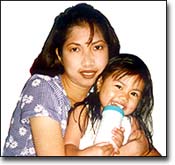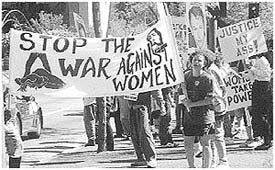The Murder of Claire
Joyce Tempongko . . .
Turning Tragedy Into Change
by
Tanya Brannan
 On
October 21, I gave a talk at an event sponsored by Prison Radio
in San Francisco called "How to Radically Transform Policing."
My talk was about the need for the police accountability movement
to embrace and prioritize holding police accountable for their
failure to protect women from the violent men who brutalize
them. Otherwise, more women will die.
On
October 21, I gave a talk at an event sponsored by Prison Radio
in San Francisco called "How to Radically Transform Policing."
My talk was about the need for the police accountability movement
to embrace and prioritize holding police accountable for their
failure to protect women from the violent men who brutalize
them. Otherwise, more women will die.
This has
to happen at the same time that we take them to task
for the brutality the police themselves wreak on our communities,
particularly communities of color. This is not a contradiction,
but a response to the differing faces of oppression.
The room
was filled with antipolice brutality luminaries, many of them
people whose work I am frankly in awe of. Not surprisingly,
their reaction to my message was somewhat skeptical.
What happened
next, however, made that message impossible to ignore. Two days
after my talk, banner headlines in the San Francisco Examiner
and Chronicle announced the murder of Claire Joyce Tempongko
by her ex-boyfriend, Tari Ramirez. Even those early reports
alluded to Joyce's multiple previous contacts with police and
district attorney representatives, and hinted at bureaucratic
bungling and "miscommunication."
The Homicide
That Law Enforcement Enables
Recently San Francisco's Commission on the Status of Women,
designated by the mayor and board of supervisors as the city
agency responsible for conducting an investigation into Claire
Joyce's murder, held a press conference and public hearing.
To say it was disappointing is an understatement.
Seven months
after the murder, the press conference was little more than
a photo op for Mayor Willie Brown and Supervisor Gavin Newsome
to pat themselves on the back for how much they care about domestic
violence, and how many millions of dollars they're going to
put into computer software and better communication systems
... as if that's really what killed Joyce Tempongko.
The Purple
Berets attended that press conference, armed with our own investigation
of Tempongko's prior contacts with San Francisco police. That
investigation outlined law enforcement failure that had begun
18 months before Joyce's death and continued, escalating with
every contact, until the night Tari Ramirez drove a knife into
her heart in the presence of her two young children. (For the
full report, go to: "The
Murder of Claire Tempongko" )
It was a
familiar litany of dropped charges and unfinished investigations;
of charging every crime except the domestic violence; of reckless
plea bargains and irresponsible sentences. It eloquently illustrated
the deadly consequences of domestic violence probation repeatedly
violated with minimal consequences to the batterer and with
appalling consequences to the victim.
And when
we confronted D.A. Terence Hallinan (whose office really
mishandled the case and whose conviction rate on domestic violence
is the lowest in the state), Hallinan responded defensively.
"This [failure
of Joyce Tempongko to follow through on prosecution] is just
an example of the etiology of the disease," he said, as if getting
Ramirez prosecuted for his crimes was Joyce Tempongko's
responsibility rather than the D.A.'s; and as if domestic violence
were a disease rather than a crime ... and a disease
of the victim at that!
Needless
to say, we were not a popular presence that day -- not with
the mayor or the D.A., and not with many of the "domestic violence
professionals" whose jobs would be history if they dared to
tell the truth of what they see every day.
But we were
an effective presence that day, as I was to learn a week
later when I picked up the Purple Berets phone to find Terence
Hallinan on the other end. He first wanted to know where we'd
gotten our information about his low conviction rate (SF Chronicle,
"D.A. Weak on Domestic Violence," 10/8/99), and then
what we thought his office could do to turn that around.
Our extended
conversation was interspersed with comments to and from Susan
Breall, Linda Moore and a third person, all of whom run the
D.A.'s domestic violence team. Talk ranged over the entire handling
of the Tempongko case, the ways their deadly mistakes could
be corrected, and the probability that a lot of other cases
in their office look exactly like this one.
Hallinan
admitted they had made mistakes, and to the ridiculousness of
his defensiveness at the press conference. ("I was an asshole,"
he said, "I mean the woman's dead!"). He also let slip
that, "You guys have kicked everybody off — [the
cops too] are reviewing their policies and procedures from top
to bottom."
Hallinan's
Commitments
By the end of the conversation, D.A. Hallinan had agreed to
both our initial demands: 1) that he immediately bring his domestic
violence conviction rate up; and, 2) that he enforce a policy
that, when domestic violence probation is violated with another
violent incident, the prosecution will move to revoke the probation
and file new felony charges on the latest incident.
But Hallinan
went even further. A key incident in the Tempongko case was
a devastating beating Claire Joyce suffered just a month and
a half before her murder. San Francisco PD's domestic violence
investigator Sgt. Al Lum unilaterally decided only to file this
as a probation violation so, according to Hallinan, the D.A.'s
office never even saw the report. When I pointed out that it
was the D.A.'s job to decide how to charge crimes, not Sgt.
Lum's, Hallinan agreed to set a policy that all domestic violence
probation violations be sent to his office for charging.
At the end
of the conversation, we came back to the likelihood that a lot
of other domestic violence cases are being handled by his office
exactly like the Tempongko cases were. How will he identify
and correct those cases so that more women don't die? I suggested
random spot-checks of cases in the office, starting with all
domestic violence probation cases. Hallinan agreed.
It remains
to be seen what will come of the Tempongko investigation —
whether it will end in a dastardly cover-up, a few cosmetic
reforms, or in truly fundamental change in how law enforcement
takes their responsibility in domestic violence protection.
But once
again we've shown that these needless and tragic homicides offer
communities a rare opportunity to make real change in a system
that systematically kills women by denying them protection.
And we've
also shown that a few people, armed only with the truth, can
change the world. But I have to ask: why did it take our investigation
and its exposure of law enforcement's failure to shake things
loose?
Correcting
the Problems That Killed Claire Joyce Tempongko
|
|
What the
District Attorney Must Change:
- Immediately
institute a policy that any violation of domestic violence
probation involving a new violent incident must result
in a motion to revoke probation and the filing of felony
charges on the new incident.
- Institute
a policy with police that all violations of domestic
violence probation are to be sent to his office for
charging.
- Implement
a review process within his office that randomly spot-checks
how DV cases are handled. To begin, check all violations
of domestic violence probation.
- Bring
his domestic violence conviction rate, currently the
statewide low at 26.8%, up to the statewide average
of 60.2
|
|
What the
Police Chief Must Change:
- Immediately
devote the resources necessary to find and arrest Claire
Tempongko's murderer, Tari Ramirez, who is still at-large.
- Institute
a policy that all violations of domestic violence probation
are to be sent to the district attorney for charging.
- Remove
Sgt. Al Lum from SFPD's domestic violence team. Lum's
irresponsible handling of the Tempongko case contributed
to her murder.
- Evaluate
members of the domestic violence team based on the conviction
rate on their cases. This would force police to do good
investigations and to fight for their cases with the
DA's offic
|



 On
October 21, I gave a talk at an event sponsored by Prison Radio
in San Francisco called "How to Radically Transform Policing."
My talk was about the need for the police accountability movement
to embrace and prioritize holding police accountable for their
failure to protect women from the violent men who brutalize
them. Otherwise, more women will die.
On
October 21, I gave a talk at an event sponsored by Prison Radio
in San Francisco called "How to Radically Transform Policing."
My talk was about the need for the police accountability movement
to embrace and prioritize holding police accountable for their
failure to protect women from the violent men who brutalize
them. Otherwise, more women will die.